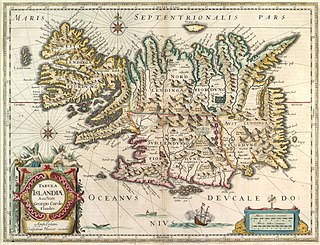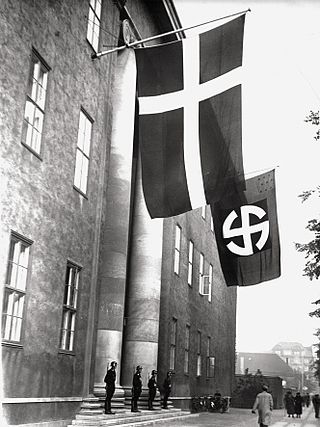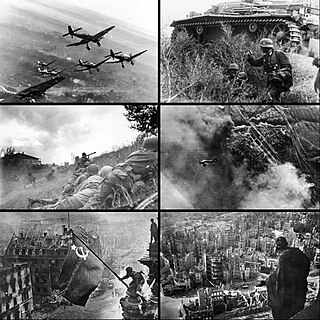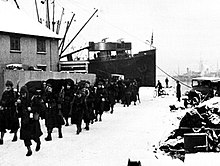
The recorded history of Iceland began with the settlement by Viking explorers and the people they enslaved from Western Europe, particularly in modern-day Norway and the British Isles, in the late ninth century. Iceland was still uninhabited long after the rest of Western Europe had been settled. Recorded settlement has conventionally been dated back to 874, although archaeological evidence indicates Gaelic monks from Ireland, known as papar according to sagas, may have settled Iceland earlier.

Iceland's defence forces consist of the Icelandic Coast Guard, which patrols Icelandic waters and monitors its airspace, and other services such as the National Commissioner's National Security and Special Forces Units. Iceland maintains no standing army, the only NATO member for which this is the case.

At the outset of World War II in September 1939, Denmark declared itself neutral, but that neutrality did not prevent Nazi Germany from occupying the country almost immediately after the outbreak of war, lasting until Germany's defeat. The decision to occupy Denmark was taken in Berlin on 17 December 1939. On 9 April 1940, Germany occupied Denmark in Operation Weserübung. The Danish government and king functioned in a relatively normal manner until 29 August 1943, when Germany placed Denmark under direct military occupation, which lasted until the Allied victory on 5 May 1945. Contrary to the situation in other countries under German occupation, most Danish institutions continued to function relatively normally until 1945. Both the Danish government and king remained in the country in an uneasy relationship between a democratic and a totalitarian system until 1943 when the Danish government stepped down in protest against German demands that included instituting the death penalty for sabotage.

The European theatre of World War II was one of the two main theatres of combat during World War II. It saw heavy fighting across Europe for almost six years, starting with Germany's invasion of Poland on 1 September 1939 and ending with the Western Allies conquering most of Western Europe, the Soviet Union conquering most of Eastern Europe including the German capital Berlin, and Germany's unconditional surrender on 8 May 1945 although fighting continued elsewhere in Europe until 25 May. On 5 June 1945, the Berlin Declaration proclaiming the unconditional surrender of Germany to the four victorious powers was signed. The Allied powers fought the Axis powers on two major fronts, but there were other fronts varying in scale from the Italian campaign, to the Polish Campaign, as well as in a strategic bombing offensive and in the adjoining Mediterranean and Middle East theatre.

Almost every country in the world participated in World War II. Most were neutral at the beginning, but only a relative few nations remained neutral to the end. The Second World War pitted two alliances against each other, the Axis powers and the Allied powers; the Soviet Union mobilised 34 million men and women, Germany 18 million, the U.S 16 million, Japan 9 million, and Great Britain 6 million. It is estimated that in total, 126 million people were mobilised during the war. It is generally estimated that a total of 72 million people died, with the lowest estimate being 40 million dead and the highest estimate being 90 million dead. The leading Axis powers were Nazi Germany, the Empire of Japan and the Kingdom of Italy; while the British Empire, the United States, the Soviet Union and China were the "Big Four" Allied powers.

The Allies, formally referred to as the United Nations from 1942, were an international military coalition formed during World War II (1939–1945) to oppose the Axis powers. Its principal members by the end of 1941 were the "Big Four" - United Kingdom, United States, Soviet Union, and China.
Operation Ikarus was a Second World War German plan to invade Iceland, which had been occupied by British forces during Operation Fork in 1940. The plan was never realized.

The neutral powers were countries that remained neutral during World War II. Some of these countries had large colonies abroad or had great economic power. Spain had just been through its civil war, which ended on 1 April 1939 —a war that involved several countries that subsequently participated in World War II.

Foreign relations of the Axis powers includes states which were not officially members of the Axis but had relations with one or more Axis members.

The Kingdom of Iceland was a sovereign and independent country under a constitutional and hereditary monarchy that was established by the Act of Union with Denmark signed on 1 December 1918. It lasted until 17 June 1944 when a national referendum established the republic of Iceland in its place.
The British invasion of Iceland by the United Kingdom's Royal Navy and Royal Marines occurred on 10 May 1940, during World War II. The invasion took place because the British government feared that Iceland would be used militarily by Nazi Germany, which had overrun Denmark a month earlier. Although Iceland was independently governed, it was in a personal union with Denmark, which was largely responsible for its foreign relations. The Government of Iceland issued a protest, charging that its neutrality had been "flagrantly violated" and "its independence infringed".

The Kingdom of Iceland was occupied by the Allies during World War II, beginning with a British invasion intent on occupying and denying Iceland to Germany. The military operation, codenamed Operation Fork, was conducted by the Royal Navy and Royal Marines. In time, some of the British garrison was replaced by Canadian and later American forces, despite the fact that the United States was not yet in the war.
This is a brief overview of historical warfare and recent developments in Iceland. Iceland has never participated in a full-scale war or invasion and the constitution of Iceland has no mechanism to declare war.

Icelandic–British relations are foreign relations between Iceland and the United Kingdom.

Germany–Iceland relations are the bilateral relations between Germany and Iceland. Both countries are also members of the Organisation for Economic Co-operation and Development, the Organization for Security and Cooperation in Europe, the Council of the Baltic Sea States and the Schengen area.

Operation Weserübung was the invasion of Denmark and Norway by Nazi Germany during the Second World War and the opening operation of the Norwegian Campaign.

Iceland Base Command (IBC) is an inactive United States Army organization. It was established for the United States defense of the Kingdom of Iceland during World War II. It was inactivated on 4 March 1947.

Throughout the Cold War, the nation of Iceland was a member of the North Atlantic Treaty Organization (NATO) and allied with the United States, hosting a US military presence in Keflavík Air Base from 1951 to 2006.

The Danish–Icelandic Act of Union, an agreement signed by Iceland and Denmark on 1 December 1918, recognized Iceland as a fully independent and sovereign state, known as the Kingdom of Iceland, which was freely associated to Denmark in a personal union with the Danish king. Iceland established its own flag, declared its neutrality and asked Denmark to represent on its behalf foreign affairs and defence interests, while maintaining full control of them. Iceland opened its first embassy in 1920. The Act would be up for revision in 1940 and could be revoked three years later if agreement was not reached.
France was one of the largest military powers to come under occupation as part of the Western Front in World War II. The Western Front was a military theatre of World War II encompassing Denmark, Norway, Luxembourg, Belgium, the Netherlands, the United Kingdom, France, Italy, and Germany. The Western Front was marked by two phases of large-scale combat operations.

















